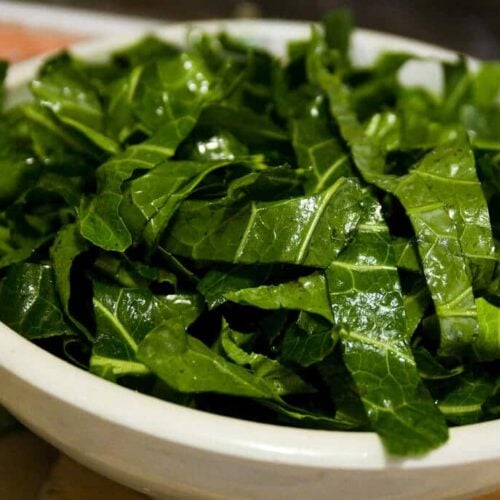Mustard greens are the leaves of the mustard plant, and can have either a crumpled or flat texture, and may have toothed, scalloped, frilled or lacey edges.
These often overlooked greens are packed with flavor and nutrition. In their raw form, they are mildly peppery and fresh tasting, and sauteed, they make a great substitute for kale or collard greens. Here’s how to prepare them for best flavor…
Mustard Green Nutrition
Mustard greens are jam-packed with nutrients. They provide excellent amounts of 9 vitamins and 7 minerals, including Vitamins A, C, E, K, folate and magnesium.
And if that were not impressive enough, being a member of the Brassica family along with broccoli, cabbage and Brussels sprouts, they also feature the same cancer-fighting, health-promoting phytonutrients known as glucosinolates.
Selection and Storage of Mustard Greens
Mustard greens grow in a rosette of leaves about a foot-and-a-half tall. You can cook with the big peppery greens or pick smaller, young leaves to eat raw in salads and sandwiches.
Purchase mustard greens that are unblemished and free from any yellowing or brown spots. They should look fresh and crisp and be a lively green or purple-green color.
Mustard greens should be stored in a plastic bag in the refrigerator. They should keep fresh for about three to four days.
Preparing Mustard Greens
The easiest way to clean the leaves is the same way you would clean spinach or kale: Place the mustard greens in a large bowl of tepid water and swish them around with your hands. This will allow any sand or dirt to become dislodged.
Remove the greens from the water, empty the bowl, refill with clean water and repeat this process until no sand or dirt remains in the water (usually two or three times will do the trick).
For basic mustard green preparation, wash the leaves and fold in half with the top of the green folded inward. Cut along the stem and remove. Or, if you plan to cook the greens for a long time, such as when using them in soup, you can keep the leaves intact with their center stem.
Young, raw mustard greens make a great addition to any kind of salad, as well as an exciting alternative to lettuce in a sandwich. Your can also add chopped mustard greens to pasta gives it a little kick.
Piquant mustard is often mixed with hearty collards and flavorful turnip greens, tossed in the pot with some ham hocks and gently simmered for an hour or two, until the mix is meltingly tender. It is this traditional “mess o’ greens” that is featured at most Southern celebrations and large family dinners.
The pot-likker at the bottom—the vitamin-rich, green broth that results from the long simmering—is highly prized and is traditionally sopped up with a piece of fresh cornbread.
If Southern cooking doesn’t appeal to you, sautée mustard greens with almost any protein, grain or vegetable you like, especially sweet veggies like yams and carrots. Just keep in mind that mustard is more tender than collards or kale, so needs less cooking to make it soft.
To decrease the spicy flavor of raw mustard greens, cook them in boiling water for one minute before sautéeing. Then sautée in your choice of fat or oil until tender, about 15 minutes.
Here’s a unique way I like to enjoy mustard greens, which combines all the health benefits of raw food with plenty of nutritious, clean fat for maximum mineral absorption.
Other Recipes for Leafy Greens

Mustard Greens with Garlic Mayonnaise
Ingredients
Garlic Mayonnaise
- 2 egg yolks, from pasture-raised eggs
- 1 teaspoon Dijon mustard
- 1-2 cloves garlic, peeled
- 1/4 teaspoon cayenne pepper
- 2 tablespoons fresh lemon juice, (freshly squeezed)
- 1 cup avocado oil, or extra-virgin olive oil
- sea salt, to taste
Mustard Greens
- 3/4 pound mustard greens, stemmed and chopped
- 1/2 red bell pepper, finely minced (optional)
- ground black pepper, to taste
Instructions
Garlic Mayonnaise
- Combine the egg yolks, mustard, garlic clove, cayenne and lemon juice in a food processor. (Or use a stick blender)
- Start to process, and as the machine runs, very slowly add the oil in a thin stream through the top spout. The mayonnaise will come together and thicken all of a sudden.
- If the mixture is too thick, add a little warm water to thin it.
- Add salt and pepper to taste.
- The mayonnaise will keep for about 1 week in the refrigerator.
- Enjoy with mustard greens (above), or any dish that calls for mayonnaise.
Mustard Greens
- Rinse and dry the mustard greens.
- Slice away the stems, fold over the leaves and cut them into bite-size pieces.
- In a large bowl, toss the mustard greens and the minced pepper (if using) with a little of the mayonnaise, adding a little at a time and tasting as you go. The leaves should be lightly coated but not soggy with the mayonnaise.
- Add freshly ground black pepper, to taste.








